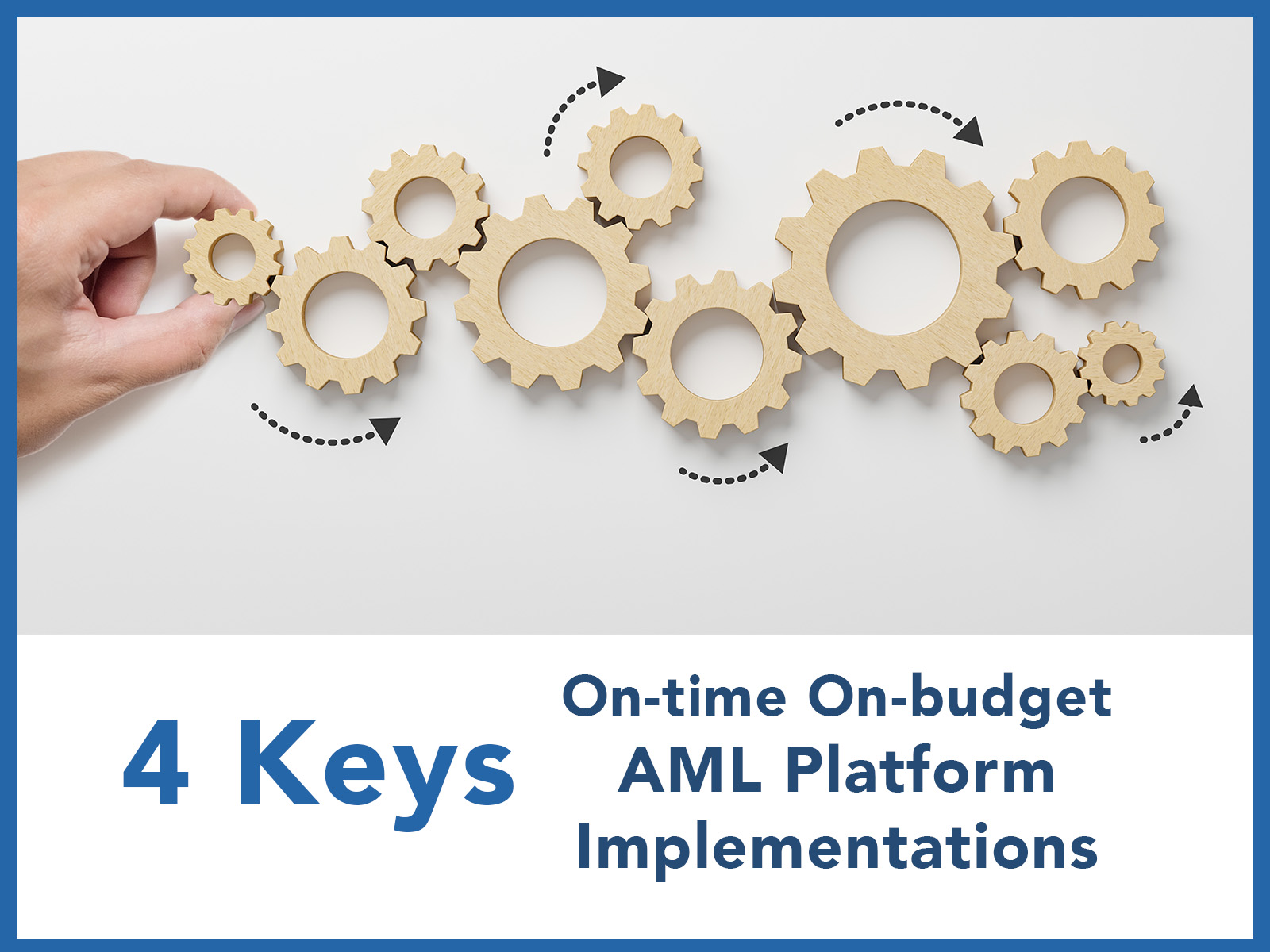
Go live on schedule: Four keys to successful AML platform implementations
In my experience over more than two decades in the field, four keys help deliver successful AML platform implementations that go live on-time and on-budget:
Key #1: Build the operational system that you need, not the perfection that you want.
Key #2: Strive for that perfection in subsequent phases, not in the initial AML platform implementation.
Key #3: Agree on what will be delivered—and when—in writing at the beginning of the project.
Key #4: Don’t get distracted by possibility. Stick with the plan as written; add enhancements later.
Key #1: Build the AML solution you need right now
AML Partners has been implementing AML solutions for more than a decade, and we have learned a thing or ten. My most important advice to our clients is this: Don’t let the pursuit of perfection outweigh—or entirely trample—achieving an extremely operational system that goes live on time and on budget.
With today’s platform technology—like our own RegTechONE platform for AML—Compliance teams marvel at the agility and flexibility. No-code configurability, in fact, is one of the biggest selling points of our platform technology. But that world of possibility can cause Compliance teams to lose sight of what they planned in their AML implementations. And when teams lose sight of their original plan, going live on time and on budget becomes impossible.
Teams, and sometimes individuals, get fixated on making changes, and they want to veer away from their initial plan. That kind of ‘perfection now’ impulse can derail projects and make on-time go-live delivery of the original plan impossible. These off-plan implementations can become extraordinarily time-consuming for both the institution and the vendor.
Key #2: Work toward perfection in subsequent phases
We at AML Partners are great supporters of the desire to achieve the perfect AML solution. It’s what drives innovation in our software design, and it’s what makes inroads in the fight against financial crime. But we encourage our clients to embrace working toward perfection over time and in phases.
The initial AML platform implementation should achieve an excellent operational system—one that works at a high level and goes into production on time and on budget. Because our platform architecture prioritizes flexibility, adaptability, no-code configurability, and myriad API connectivity, perfection just requires additional work over time.
Plan to achieve perfection in phases, and plan to re-achieve as the regulatory environment evolves. But don’t let anxiety or desire for perfection derail an on-time go-live delivery of a strong initial implementation.
Key #3: Commit in writing to a detailed implementation plan
Carefully strategize a plan. Commit it to writing. Get agreement from all.
An unwillingness to commit to a written plan is a common corollary of the problematic desire for perfection during initial implementation. And this is problematic x10 when implementing an agile and flexible AML platform that can do and be nearly anything an institution wants.
Teams often resist completing a Business Requirements Document (BRD), i.e. the detailed implementation plan. (To see a definition and tips for a BRD in general, checkout this link. AML Partners provides its own RegTech-specific BRD template at the beginning of any project with a new or existing client.) An institution’s team members sometimes justify resistance to completing a BRD by emphasizing the constant change in their world. But that’s where Rule #2 applies: Achieve perfection in phases. To be clear, resistance to building and adhering to a BRD compromises a vendor’s ability to achieve go-live implementation on time and on budget.
With an AML platform, Compliance teams can regularly retool what perfection means as regulations change, or as their institution changes. An excellent AML platform handles change as part of its architecture. Adapting toward perfection just requires configuration. It’s like hitting the ‘easy button’ in AML Compliance—no hard-coding required.
Institutions should assuage their historical fears of ‘it’s now or never’ during initial implementation. When that fear resolves, their teams can confidently commit in writing to an implementation plan. And that written implementation plan—the BRD—helps ensure that a strong operational system goes into production on time and on budget.
Key #4: Don’t get distracted by ‘possibility’—stick with your AML implementation plan
Key #3 emphasizes making a strong plan, and Key #4 is to stick with that plan. Often, team members will get distracted by their growing sense of possibility—of integrations or offshoots or drilldowns that add value. But strong initial implementations—operational, on time, and on budget—benefit immeasurably by refusing to get distracted by other/additional possibilities.
We are fans of new ideas, but we advocate strategies to capture new ideas and then ‘park’ them for implementation in later phases. When teams commit to norms that prioritize high-quality planning and adherence to the plan, both the client-side and vendor-side teams can share the same roadmap and move toward an on-time delivery in peak initial form.
The overall implementation project can formalize when and how next phases, including perfection planning, will be undertaken. But that work should not distract from successful completion of the initial implementation.
The bottom line: Plan the AML implementation work, and work that plan
With today’s flexible platform solutions, institutions can save tremendous amounts of time and money by carefully planning their Business Requirements Document and then working that plan. And they will still retain endless opportunities to work toward AML perfection—regardless of the changes over time in their institution or the regulatory environment. To go live on time and on budget, plan the work and adhere to the plan.

